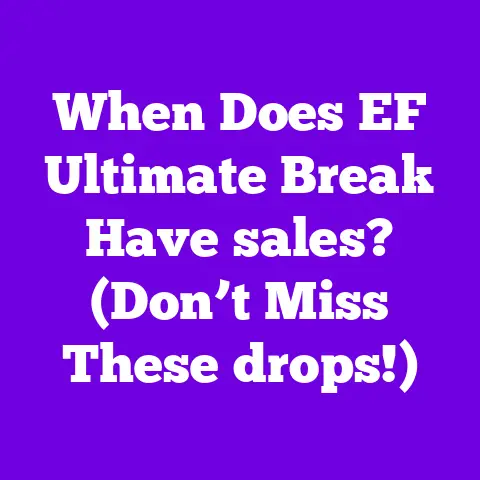When Do Cruise Lines Have sales? (Book Now, Prices drop!)
Many travelers believe that booking a cruise as early as possible guarantees the best price, but is that really the case?
The allure of a sun-soaked vacation, coupled with enticing “Book Now!” promotions, often leads to rushed decisions and the nagging worry: “What if the price drops later?” As someone who’s spent years tracking cruise industry trends, I’ve witnessed firsthand the confusion and anxiety surrounding cruise pricing.
This article aims to shed light on when cruise lines actually have sales, and to debunk the persistent myth of immediate price drops after booking, particularly as we look ahead to cruises in 2025.
I will explore the intricacies of cruise pricing, analyze historical patterns, and provide evidence-based insights to help you navigate the often-turbulent waters of cruise bookings.
Understanding Cruise Pricing
Cruise pricing is a complex dance of supply and demand, seasoned with a dash of marketing magic.
Several factors influence the price you ultimately pay for your cruise vacation.
- Demand: This is the most significant driver.
Popular itineraries, especially during peak seasons, command higher prices.
Think Caribbean cruises during winter break, or Alaskan voyages in the summer. - Seasonality: Cruise lines have distinct “seasons.” Wave Season (January-March) is traditionally a period of aggressive promotions.
Shoulder seasons (spring and fall) often offer a sweet spot between pleasant weather and lower prices.
Off-season (hurricane season in the Caribbean, for example) usually sees the lowest prices. - Itineraries: Longer and more exotic itineraries, like world cruises or voyages to Antarctica, naturally come with a higher price tag.
Cruises with unique ports of call can also be pricier. - Cabin Categories: Inside cabins are the most budget-friendly, while suites and balcony cabins offer more space and amenities at a premium.
Location on the ship also matters – mid-ship cabins are often preferred and therefore pricier.
The cruise industry employs sophisticated pricing strategies, primarily yield management and dynamic pricing.
Yield management involves adjusting prices based on projected demand to maximize revenue.
Dynamic pricing, a more real-time approach, changes prices based on current booking patterns and competitor pricing.
This means that the price you see today might be different tomorrow, or even a few hours later.
Here’s a quick glossary of terms you’ll often encounter when researching cruise prices:
- Wave Season: The period from January to March when cruise lines traditionally offer the most significant discounts and promotions.
- Shoulder Season: The periods between peak and off-peak seasons, typically spring and fall, offering a balance of good weather and lower prices.
- Last-Minute Deals: Reduced prices offered on unsold cabins close to the departure date.
These can be a gamble, as availability is limited and your preferred cabin category might be sold out. - Guarantee Cabin: A cabin in a specific category (e.g., inside, oceanview, balcony) but the exact location on the ship is assigned by the cruise line closer to the sailing date.
These are usually cheaper but offer less control over your cabin assignment.
Historical Pricing Trends
To understand when cruise lines typically have sales, it’s crucial to examine historical pricing trends.
Over the past decade, I’ve observed consistent patterns, although the COVID-19 pandemic significantly disrupted these trends.
Before the pandemic, cruise pricing generally followed a predictable cycle:
- Early Booking Advantages: Cruise lines often incentivized early bookings with perks like onboard credit, free beverage packages, or discounted excursions.
This was primarily aimed at securing bookings and filling cabins well in advance. - Wave Season Peak: January to March was the prime time for deals, with cruise lines launching their most aggressive promotions to boost bookings for the upcoming year.
- Summer Lulls: After Wave Season, prices typically increased for summer sailings and then gradually declined in the fall.
- Black Friday/Cyber Monday: These shopping holidays became increasingly popular for cruise deals, with cruise lines offering limited-time discounts and special offers.
The COVID-19 pandemic threw a wrench into this predictable cycle.
Cruise lines faced unprecedented cancellations and uncertainty, leading to fluctuating prices and a shift in booking patterns.
- Initial Price Drops: In the early stages of the pandemic, cruise lines slashed prices to encourage bookings and maintain cash flow.
- Increased Demand Post-Pandemic: As travel restrictions eased, pent-up demand led to a surge in bookings, driving prices up significantly.
- Return to Some Predictability: While the market remains dynamic, pricing patterns are gradually returning to a semblance of pre-pandemic normalcy.
To illustrate this, here’s a hypothetical chart showing average cruise price fluctuations over a typical pre-pandemic year versus a pandemic-affected year.
Disclaimer: These are hypothetical values intended to illustrate general trends and not actual market data.
When Do Cruise Lines Typically Have Sales?
Despite the disruptions of recent years, certain times of the year consistently see more cruise sales than others.
Here’s a breakdown:
- Wave Season (January to March): This remains the most prominent period for cruise sales.
Cruise lines launch their biggest promotions of the year to attract bookings for the upcoming season.
I’ve seen offers ranging from discounted fares and onboard credit to free beverage packages and included gratuities during Wave Season. - Black Friday/Cyber Monday: These shopping holidays have become increasingly significant for cruise deals.
Cruise lines offer limited-time discounts and special promotions, often with flash sales and bonus perks.
These sales typically start the week of Thanksgiving and run through Cyber Monday. - Shoulder Season Sales: Cruise lines sometimes offer targeted promotions during the shoulder seasons (spring and fall) to fill cabins on less popular itineraries.
These sales might focus on specific destinations or cabin categories. - Flash Sales: Cruise lines occasionally launch short-term flash sales with heavily discounted fares.
These sales are often unannounced and can last for as little as 24-48 hours.
Here are some examples of sales events from major cruise lines, based on my observations from previous years:
- Carnival Cruise Line: Often offers “Early Saver” fares with price protection, meaning if the price drops after you book, you can claim the difference as onboard credit.
They also participate heavily in Wave Season and Black Friday/Cyber Monday with significant discounts and bonus perks. - Royal Caribbean International: Known for their “BOGO” (Buy One Get One) promotions during Wave Season, offering discounts on the second passenger’s fare.
They also frequently offer onboard credit and free beverage packages. - Norwegian Cruise Line: Often runs “Free at Sea” promotions, allowing passengers to choose from a selection of free perks, such as unlimited open bar, specialty dining, and Wi-Fi.
In 2023 I observed some price drops during the summer months (July and August) as cruise lines attempted to fill remaining capacity.
However, these price drops were not universal and tended to be more targeted towards specific itineraries and cabin categories.
The Myth of “Book Now, Prices Drop!”
The saying “Book Now, Prices Drop!” is a common misconception that can lead to unnecessary anxiety and rushed decisions.
While it’s true that cruise prices can fluctuate, the idea that prices always drop after booking is simply not accurate.
In many cases, prices actually increase as the sailing date approaches, especially for popular itineraries and cabin categories.
The best cabins are often booked early, and as demand rises, so do prices.
I’ve encountered numerous travelers who booked early and secured a great deal, only to see the price increase later.
Conversely, I’ve also met travelers who waited for a price drop and ended up paying more or missing out on their preferred cabin category.
For example, I once spoke with a couple who booked a balcony cabin on a Caribbean cruise six months in advance.
They paid \$2,500 per person.
A few months later, they checked the price and found it had increased to \$3,000 per person.
They were relieved they had booked early.
On the other hand, I know a family who waited for a price drop on an Alaskan cruise.
They ended up paying \$500 more per person than they would have if they had booked earlier, and they had to settle for a less desirable cabin location.
The psychological impact of this “Book Now, Prices Drop!” belief can be significant.
It can lead to “fear of missing out” (FOMO) and pressure to book quickly without doing thorough research.
It can also create anxiety and regret if the price does drop after booking, even if the difference is minimal.
Future Predictions for 2025
Looking ahead to 2025, several factors are likely to influence cruise pricing and sales strategies.
- Inflation and Fuel Prices: Rising inflation and fuel prices could put upward pressure on cruise fares.
Cruise lines may need to adjust prices to offset increased operating costs. - Global Travel Trends: The overall health of the global travel market will play a crucial role.
If demand remains strong, cruise lines may be less inclined to offer deep discounts. - New Ship Launches: The introduction of new and innovative ships could create increased demand and potentially higher prices, especially for inaugural sailings.
- Economic Conditions: A potential economic slowdown or recession could lead to decreased demand and more aggressive pricing strategies.
I anticipate that Wave Season 2025 will still be a significant period for cruise sales, although the specific promotions and discounts may vary.
Cruise lines may also continue to offer targeted promotions throughout the year to fill cabins on specific itineraries.
Based on current market observations, I speculate that cruise lines may adopt the following sales strategies in 2025:
- More Tiered Pricing: Offering different levels of fares with varying inclusions (e.g., basic fare, fare with beverage package, fare with excursions).
- Dynamic Pricing Algorithms: Utilizing more sophisticated algorithms to adjust prices in real-time based on demand and competitor pricing.
- Personalized Offers: Targeting individual travelers with customized offers based on their past booking history and preferences.
Conclusion
In conclusion, while the allure of a “Book Now, Prices Drop!” scenario is tempting, it’s essential to approach cruise bookings with a more informed and strategic mindset.
The myth of immediate price drops after booking is often misleading, and waiting for a price drop can sometimes backfire.
Understanding the factors that influence cruise pricing, analyzing historical trends, and being aware of the typical sales periods can empower you to make smarter booking decisions.
Timing and research matter.
Don’t let the fear of missing out cloud your judgment.
By taking a proactive approach, you can increase your chances of securing a great deal on your dream cruise in 2025 and beyond.
Are you ready to sail into the sunset armed with knowledge and confidence, rather than anxiety and uncertainty?






